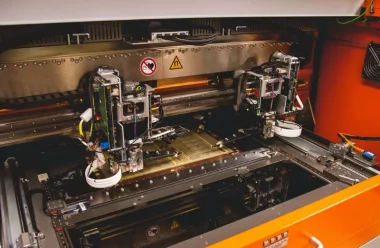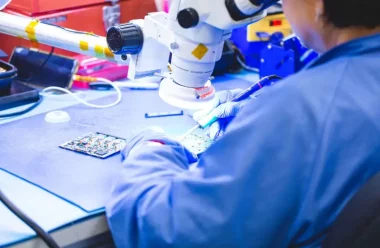In a world where technology grows more complex by the day, it’s often the small, hidden components that make the biggest differences. When it comes to the electronics industry, one such component is the printed circuit board (PCB). This tiny powerhouse is the foundation of virtually all electronics, serving as the nerve center that directs electrical signals where they need to go.
Yet, as essential as they are, PCBs can be intricate and time-consuming to assemble. This is where turn-key PCB assembly — a service model that streamlines the entire production process — can be a game-changer. By bundling all elements of PCB production, turn-key solutions are reshaping the industry, offering benefits that range from cost savings to reduced time-to-market.
In this guide, we’ll unravel the intricacies of turn-key PCB manufacturing and assembly to help you better understand how this service model can enhance your operational efficiency, reduce PCB costs, and strengthen your competitive standing in today’s dynamic electronics market.
What Is Turn-Key PCB Assembly?
Turn-key PCB assembly refers to a service model where the supplier takes complete responsibility for all aspects of the PCB project. From parts procurement to component assembly, the supplier serves as a one-stop solution, freeing the customer from the complexities of PCB production.
Moreover, many turn-key PCB assembly providers utilize cloud-based software and collaborate with PCB manufacturers to develop printed circuit boards swiftly, effectively, and economically. This allows businesses of all sizes — particularly smaller ones — to benefit from professional, high-quality PCB assembly without the overhead associated with in-house production.
To help you better navigate the world of turn-key PCB assembly, let’s clarify some commonly used terms in the industry:
- Lead times: This term refers to the period from the initiation of a process until its completion. In the context of PCB assembly, it means the time from when an order is placed until the assembled PCBs are ready for shipment. Shorter lead times in turn-key assembly translate to faster time-to-market for your products.
- Bill of materials (BOM): This is a comprehensive list of components, parts, assemblies, and other materials required to assemble a PCB. It also includes the quantities and location of each component.
Benefits of Turn-Key PCB Assembly
Turn-key PCB assembly is a highly-attractive option for businesses seeking to streamline their electronics production process. By offering a one-stop solution, turn-key PCB assembly and manufacturing provide several benefits. Let’s explore these in more detail:
- Cost reduction: With a turn-key assembly solution, businesses can lower overhead costs associated with maintaining in-house assembly equipment and dedicated personnel. Furthermore, a dedicated assembly provider’s efficiency and buying power can often lead to reduced costs for parts and materials.
- Convenient prototyping: Turn-key PCB providers can often rapidly produce prototypes, allowing for early detection and rectification of design flaws. This early intervention can save time and resources in the long run, helping to ensure a smoother transition to full-scale production.
Partial vs. Full Turn-Key PCB Assembly
With turn-key PCB assembly, businesses have two primary options: partial and full turn-key assembly. Understanding the differences between the two can help you make the best decision for your specific needs.
Partial Turn-Key Assembly Pros and Cons
In a partial turn-key assembly setup, the service provider only takes responsibility for certain aspects of the assembly process. The client typically supplies some components, while the assembly provider procures the rest and assembles the PCB. This model enables the original equipment manufacturer (OEM) to maintain control over key parts of the PCB manufacturing process.
The partial turn-key assembly approach may be ideal if you already have a lot of parts on hand and want to save time and money by using them.
Making the Right Turn-Key Decision
With the surge in technological innovation and PCB demand, turn-key assembly — be it partial or full — is a game-changer for many businesses. It’s more than just a process; it’s a strategic choice that can streamline operations, expedite time-to-market, and pivot the financial scales in your favor.
The decision between partial and full turn-key assembly should be made carefully while considering your unique requirements and resources. It’s all about choosing the right solution that aligns with your business goals, capabilities, and future growth.


![Understanding PCB Costs & Pricing [Your Complete Guide] Understanding PCB Costs & Pricing [Your Complete Guide]](https://hdicircuitboard.com/wp-content/uploads/elementor/thumbs/Understanding-PCB-Costs-Pricing-Your-Complete-Guide-qzzhe6mcaxuolkux3xalfktgavumi9y1aqfbs9bpv4.webp)
![Determining PCB Via Size [w Guidelines] Determining PCB Via Size [w Guidelines]](https://hdicircuitboard.com/wp-content/uploads/elementor/thumbs/Determining-PCB-Via-Size-w-Guidelines-qzzhe6mcaxuolkux3xalfktgavumi9y1aqfbs9bpv4.webp)
![PCB Material Types Explained [Your Guide] PCB Material Types Explained [Your Guide]](https://hdicircuitboard.com/wp-content/uploads/elementor/thumbs/PCB-Material-Types-Explained-Your-Guide-qzzhe6mcaxuolkux3xalfktgavumi9y1aqfbs9bpv4.webp)

